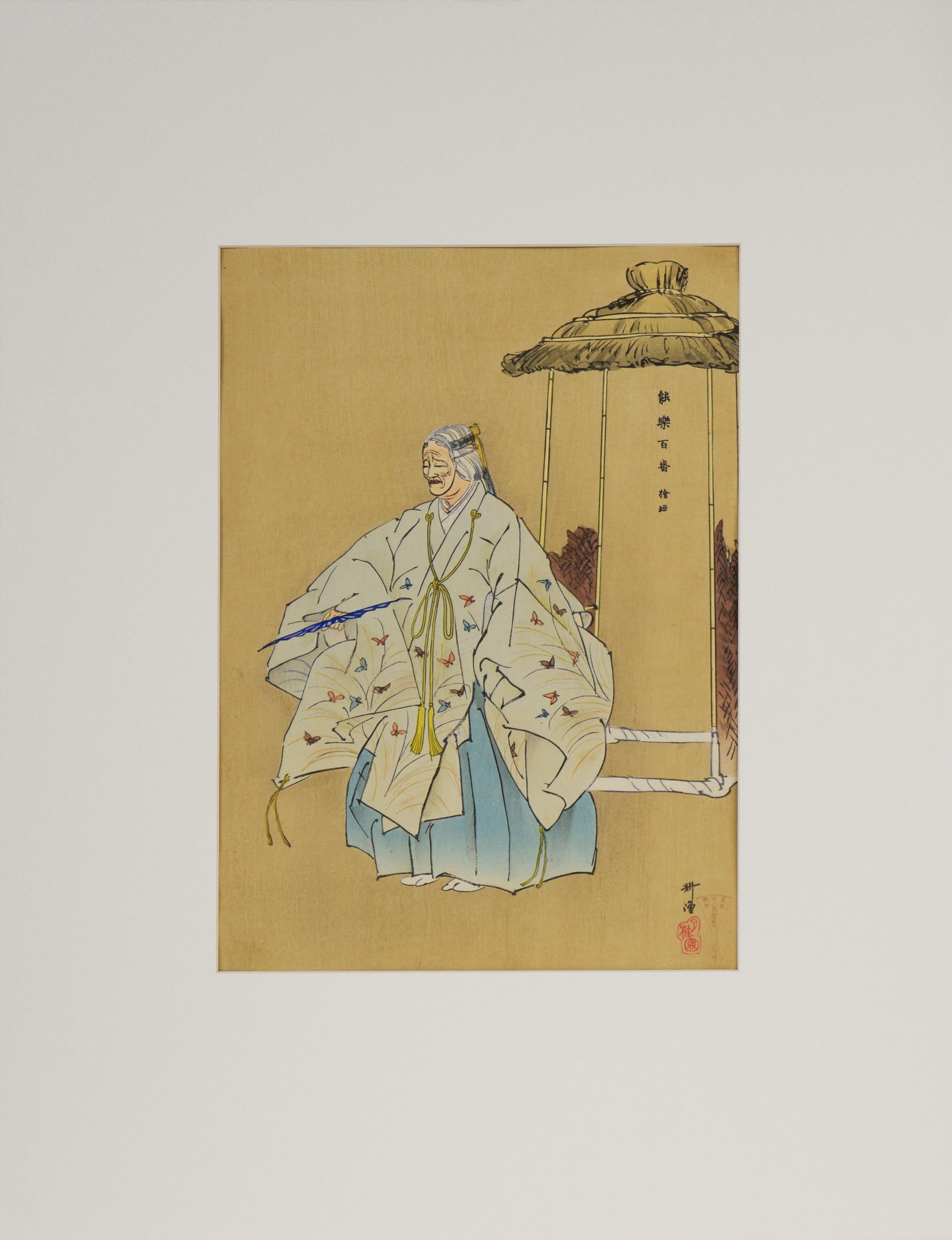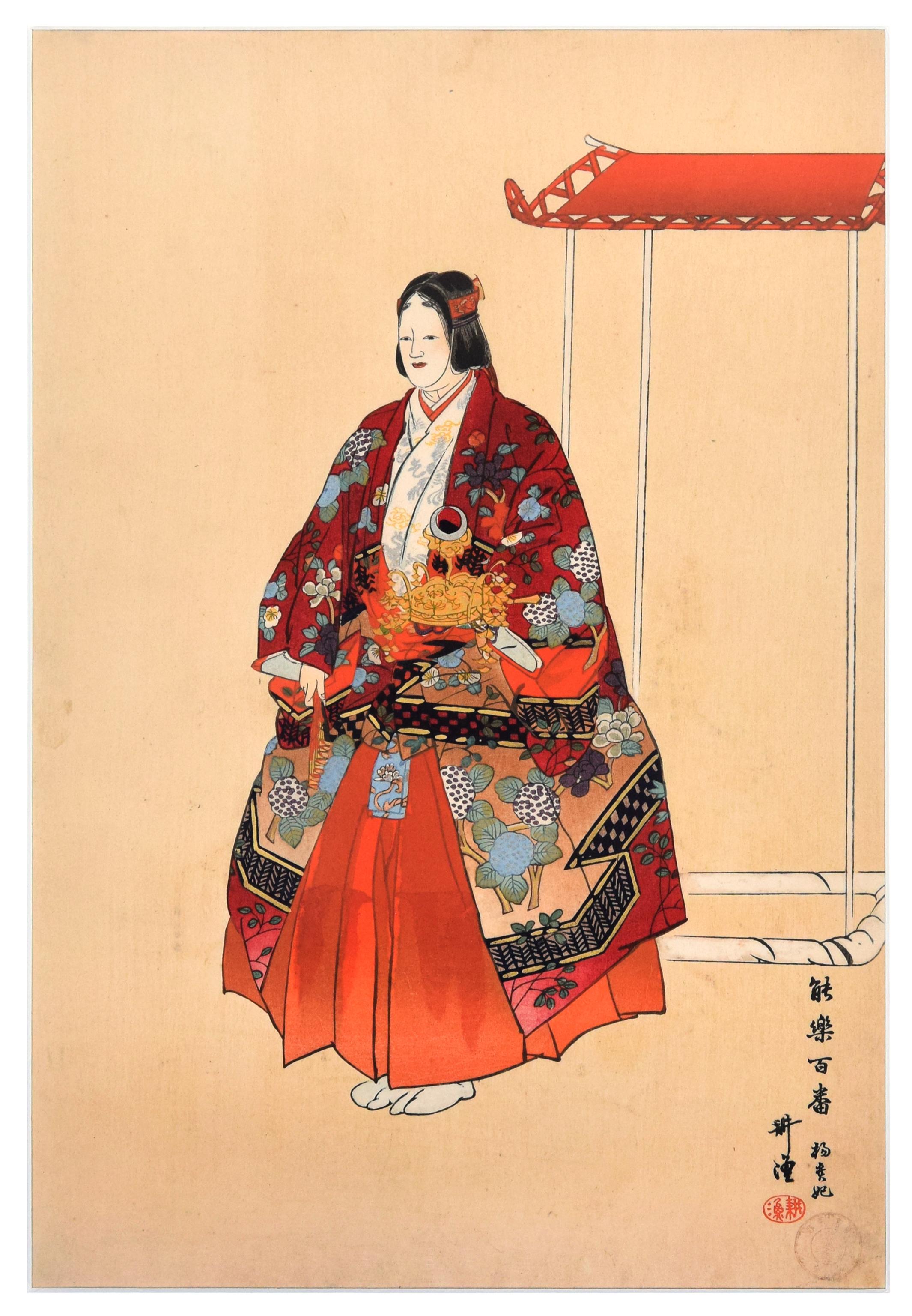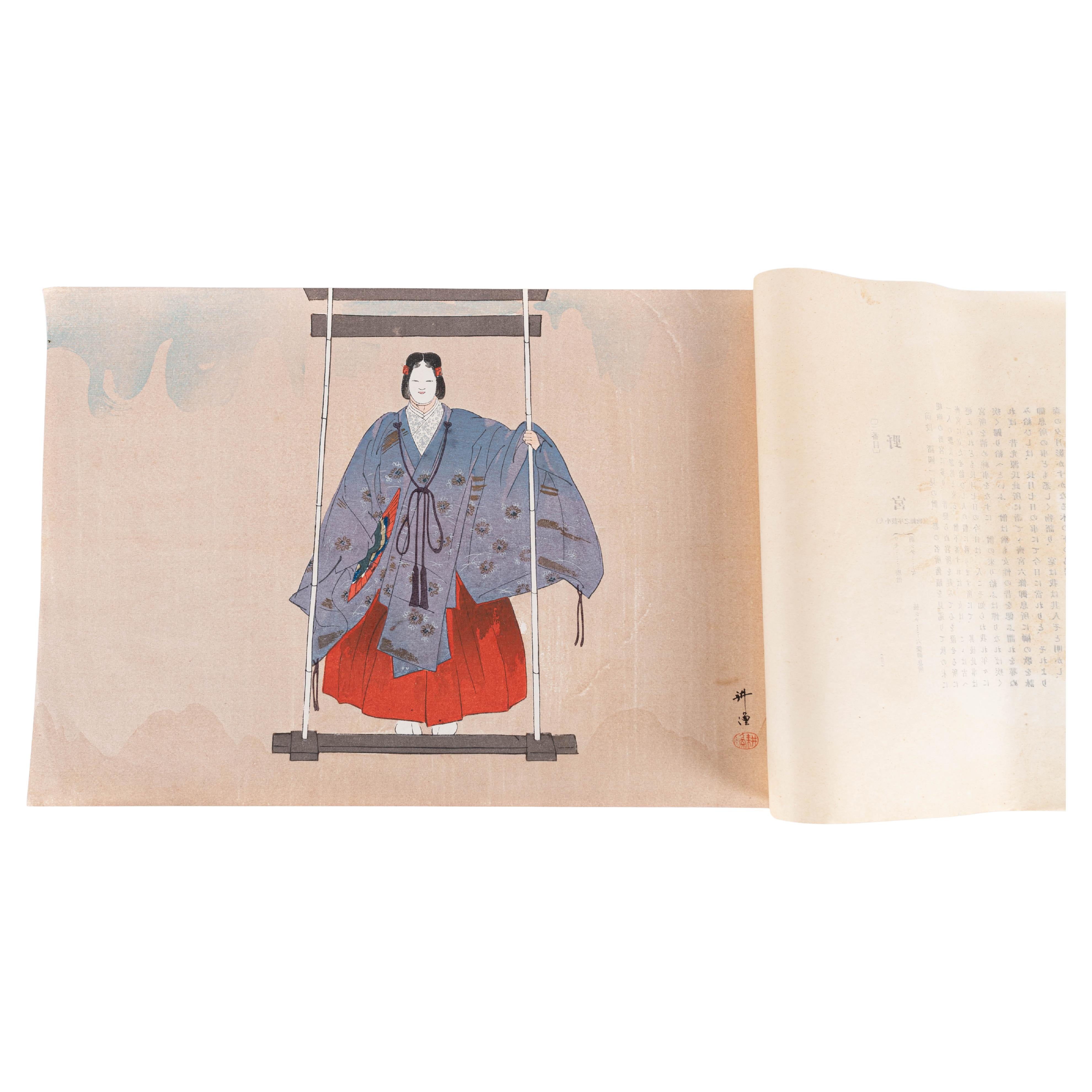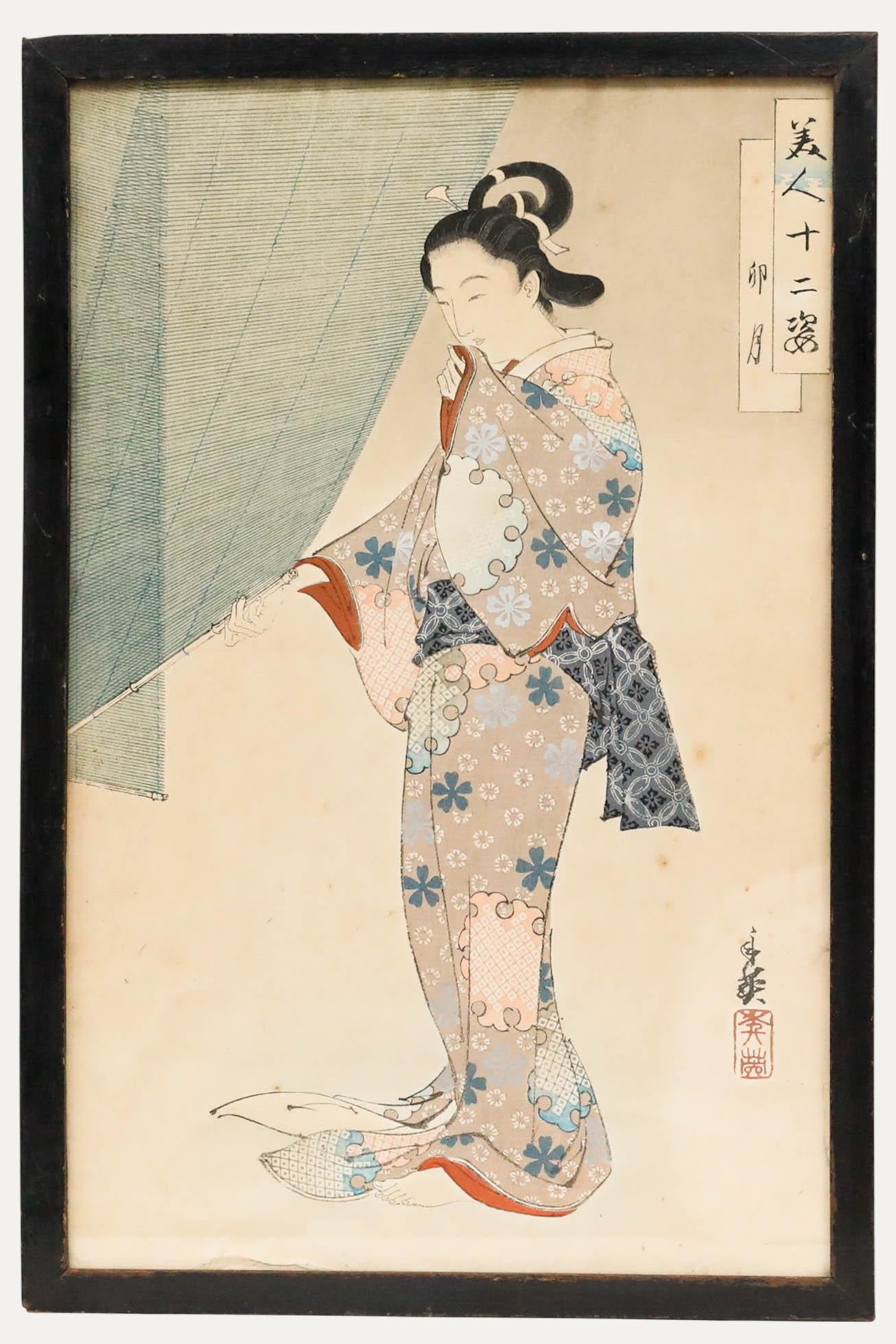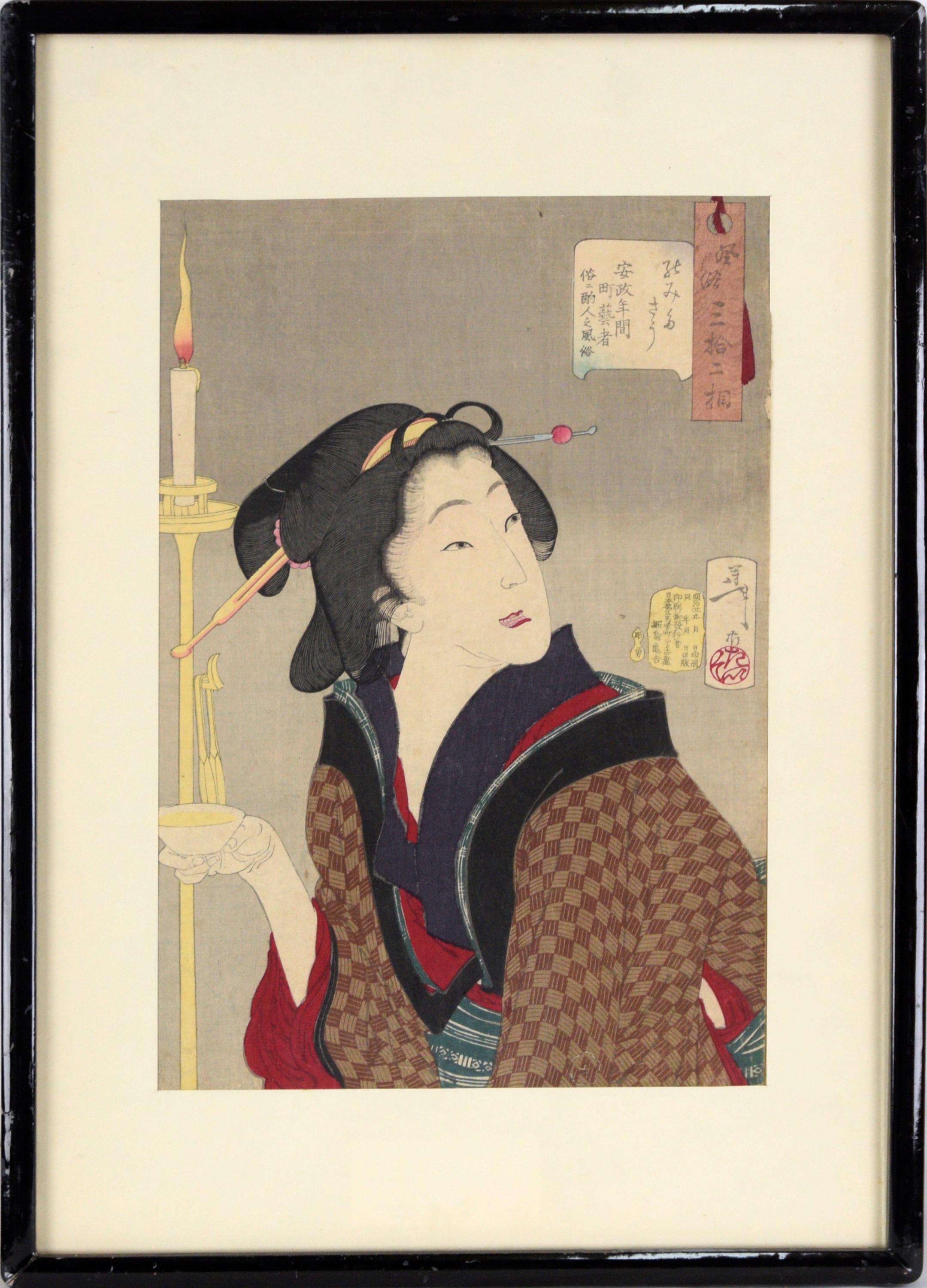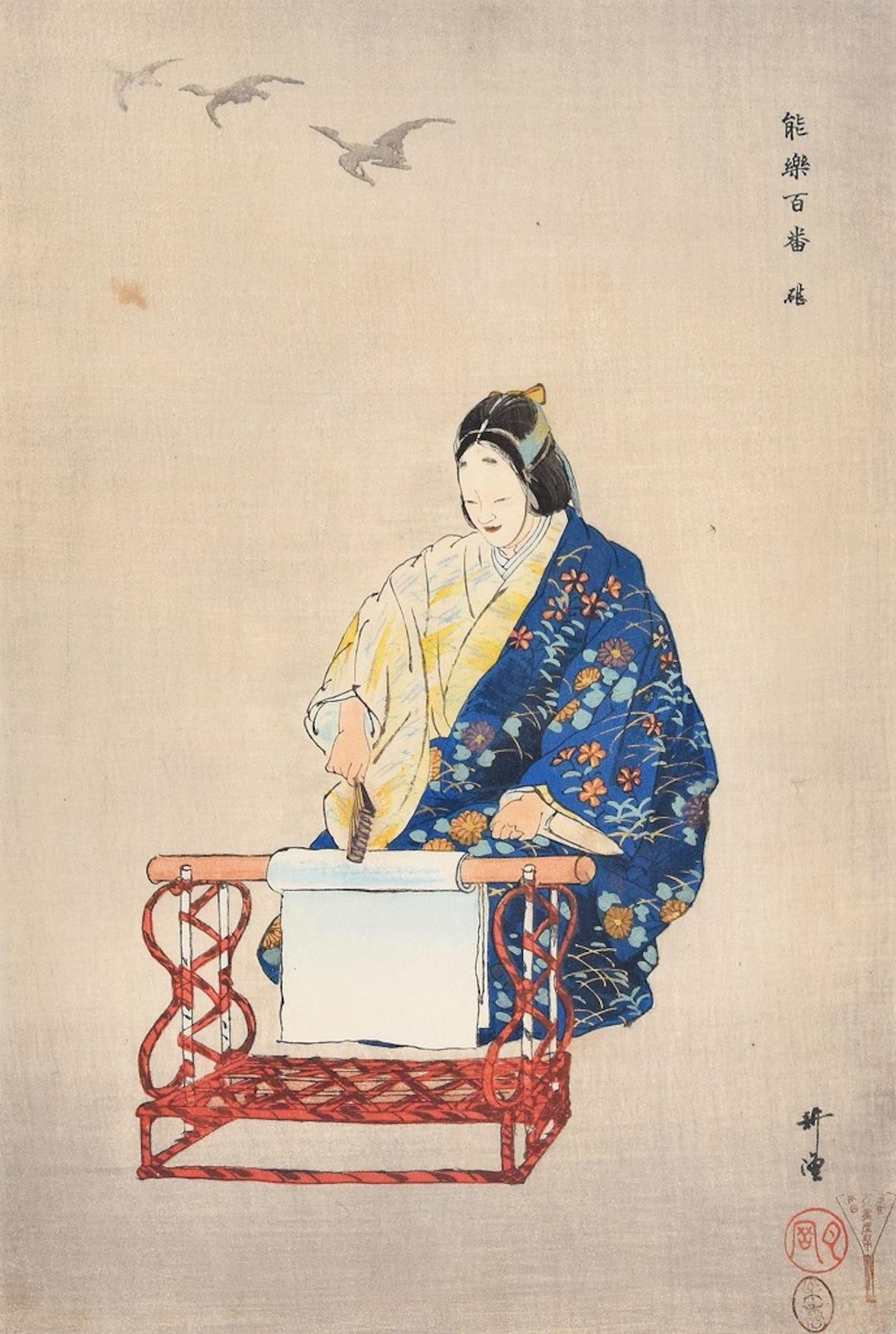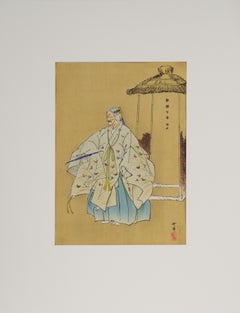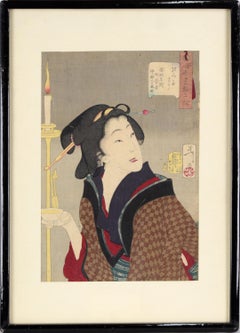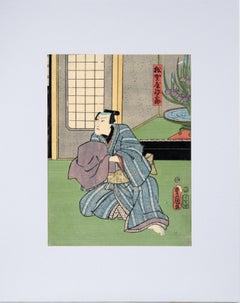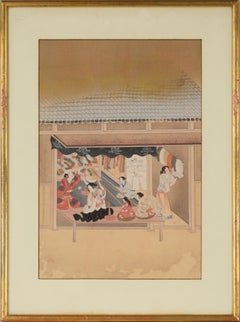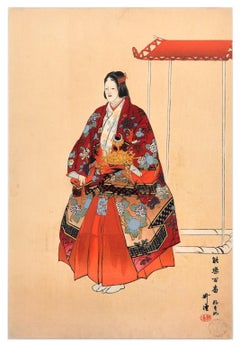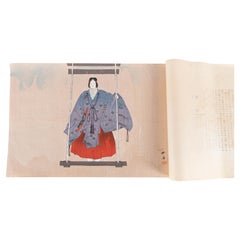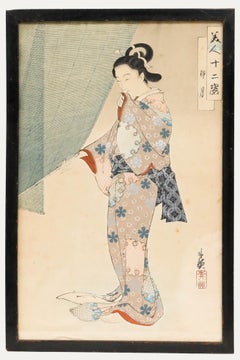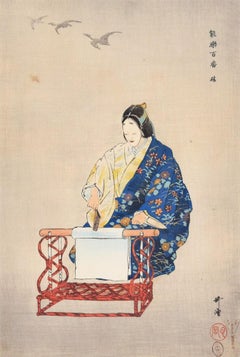Items Similar to "Pictures Of Noh" - 1922 Original Japanese Woodblock Print
Want more images or videos?
Request additional images or videos from the seller
1 of 11
Tsukioka Kôgyo"Pictures Of Noh" - 1922 Original Japanese Woodblock Print1922
1922
$710
£537.32
€617.14
CA$1,009.65
A$1,094.67
CHF 576.89
MX$13,312.29
NOK 7,177.43
SEK 6,787.45
DKK 4,607.27
About the Item
"Pictures Of Noh" - 1922 Original Japanese Woodblock Print
Original Japanese woodblock print by Tsukioka Kogyo (Japanese, 1869-1927) depicting a scene from one of Kogyo's most important series, "Pictures of Noh." A Geisha stands alone in a traditional purple and orange kimono.
Presented in a white mat.
Mat: 24"H x 18"W
Paper: 14 3/4"H x 10"W
Image: 14"H x 9 3/4"W
Tsukioka Kogyo was a Japanese artist of the Meiji period. He was a student and adopted son of Tsukioka Yoshitoshi, and also studied with Ogata Gekko. For most of his career Kogyo created prints centred on Japanese noh theatre, either as large-scale paintings or coloured woodblock prints, however he also did war and nature prints. Many of the latter were published in series and sold as multi-volume sets. Some sets have been preserved as albums in their original bindings, including accordion-style bindings known as orihon. Although original album books are primarily in institutions, single prints are popular in the Japanese antiques market.
- Creator:Tsukioka Kôgyo (1869 - 1927)
- Creation Year:1922
- Dimensions:Height: 24 in (60.96 cm)Width: 18 in (45.72 cm)Depth: 0.5 in (1.27 cm)
- Medium:
- Movement & Style:
- Period:
- Condition:Very good condition.
- Gallery Location:Soquel, CA
- Reference Number:Seller: N92821stDibs: LU54214587202
About the Seller
5.0
Platinum Seller
Premium sellers with a 4.7+ rating and 24-hour response times
Established in 1986
1stDibs seller since 2014
3,009 sales on 1stDibs
Typical response time: <1 hour
- ShippingRetrieving quote...Shipping from: Soquel, CA
- Return Policy
Authenticity Guarantee
In the unlikely event there’s an issue with an item’s authenticity, contact us within 1 year for a full refund. DetailsMoney-Back Guarantee
If your item is not as described, is damaged in transit, or does not arrive, contact us within 7 days for a full refund. Details24-Hour Cancellation
You have a 24-hour grace period in which to reconsider your purchase, with no questions asked.Vetted Professional Sellers
Our world-class sellers must adhere to strict standards for service and quality, maintaining the integrity of our listings.Price-Match Guarantee
If you find that a seller listed the same item for a lower price elsewhere, we’ll match it.Trusted Global Delivery
Our best-in-class carrier network provides specialized shipping options worldwide, including custom delivery.More From This Seller
View AllOne Hundred Prints Of The Noh - 1925 Original Japanese Woodblock Print
Located in Soquel, CA
One Hundred Prints Of The Noh - 1925 Original Japanese Woodblock Print
Original Japanese woodblock print by Tsukioka Kogyo (Japanese, 1869...
Category
1920s Edo Figurative Prints
Materials
Ink, Rice Paper, Woodcut
"Thirsty: the appearance of a town geisha in the Ansei era" - Woodblock on Paper
By Tsukioka Yoshitoshi
Located in Soquel, CA
"Thirsty: the appearance of a town geisha in the Ansei era" - Woodblock on Paper
From the series "Thirty-two Aspects of Customs and Manners" (Fuzoku sanjuniso)
Lively woodblock of a...
Category
1880s Edo Figurative Prints
Materials
Paper, Ink, Woodcut
"Sun Saburo Matsugaya" - Mid 19th Century Figurative Japanese Woodblock Print
By Utagawa Kunisada (Toyokuni III)
Located in Soquel, CA
"Sun Saburo Matsugaya" - Mid 19th Century Figurative Japanese Woodblock Print
Beautiful mid 19th century figural Japanese woodblock print of a seated man with lilies in the background by Utagawa Toyokuni III (Kunisada) (Japanese, 1786-1864/5). Artist's chop is in the lower right corner of the piece. The actor is Magosaburo Matsugaya from the play "Katakiuchi Rumors"
Presented in a new grey-blue mat with foamcore backing.
Mat size: 21"H x 16"W
Paper size: 14"H x 9.75"W
During his lifetime Kunisada Utagawa...
Category
1850s Edo Figurative Prints
Materials
Paper, Ink, Woodcut
Japanese Artisans - Silk Dying -Japanese Woodblock Print
By Tosa Mitsuyoshi
Located in Soquel, CA
Japanese Artisans - Japanese Woodblock Print J
Japanese woodblock depicting six women, all wearing vibrant kimonos, working on crafts by Tosa Mitsuoki (Japanese, 1617-1691). Japanese,c. 1600. Handcraft depiction (dye works).Section from a painted screen with presentations of handcraft.Kita-in, Saitama.
Stamped lower left.
Presented in a white mat and giltwood frame.
Frame: 19"H x 14"W
Mat: 18.25"H x 13.25"W
Image: 14.5"H x 9.5"W
Tosa Mitsuoki was a Japanese painter, reinvigorating the Yamato style of classical Japanese painting. Yamato-e originated from interest in reproducing early Tang dynasty paintings, and was later reinvented and further refined to fit Japanese cultural perceptions in the late Heian period. Yamato, sometimes referred to as wa or kazu had become synonymous with the Tosa-ha by the Muromachi period as a way for Japanese artist to distinguish their works from those of mainland Chinese paintings, kara-e. Yamato-e incorporated various visual and literary techniques for establishing narrative. Works were not always accompanied with text and may rely on heavily on period specific visual motifs, icons, and symbols to relay a story or theme. Tosa style by the time of Mitsuoki focused heavily on depicting themes of plants and nature, famous places, meisho, the four seasons, shik, bird-and-flower, kacho. Many of these popular symbols and icons from mimicking Chinese practices, treating the original Chinese masterwork as a sort of prototype to improve upon. Popular formats for Mitsuoki's pictures were wall scrolls kakemono, or handscrolls that would be read from right to left with the accompanied story, sliding doors fusuma and folding screen panels byobu that featured up to six panels. Mitsuoki's style incorporated the depth and calligraphy techniques of ink wash brushwork similar to Song dynasty and Yuan dynasty Chinese court paintings...
Category
1920s Edo Landscape Paintings
Materials
Paper, Ink, Woodcut
$1,240 Sale Price
20% Off
"Enshoku Sanju-roku Kasen" (Thirty-six Enchanting Flowers) Woodblock on paper
By Toyohara Kunichika
Located in Soquel, CA
"Enshoku Sanju-roku Kasen" (Thirty-six Enchanting Flowers) Woodblock on paper
Elegant woodblock print by Toyohara Kunuchika (Japanese, 1835-1900). Three women are in talking with each other inside, while a man waits outside holding a bag of some kind. The colors in this piece are rich and saturated, primarily blues, greens, and purple.
Mat size: 16"H x 20"W
Paper size: 14.75"H x 9.88"W
Born in 1835, Toyohara Kunichika grew up in the Kyobashi district of Edo in the midst of merchants and artisans. In 1848, at age 13, he was accepted as an apprentice into the studio of Utagawa Kunisada I...
Category
1880s Edo Figurative Prints
Materials
Ink, Rice Paper, Woodcut
"Juro Sukenari, Station #9: Oiso", Mid 19th Century Japanese Ukiyo-e Woodblock
By Utagawa Kunisada (Toyokuni III)
Located in Soquel, CA
Beautiful mid 19th century Japanese woodblock print of a samurai by Utagawa Toyokuni III (Kunisada) (Japanese, 1786-1864/5). This piece is from a series of "The 53 Stations of the To...
Category
1860s Edo Figurative Prints
Materials
Paper, Ink
You May Also Like
Yokihi - Woodcut Print by Tsukioka Kôgyo - 1923
Located in Roma, IT
Yokihi is an original print realized by Tsukioka Kôgyo in 1923.
Mixed colored woodblock print. This print is from the series "One Hundred No Dramas (No...
Category
1920s Modern Figurative Prints
Materials
Woodcut
$1,532 Sale Price
20% Off
Original Woodblock print Japan (1925), by Tsukioka Kogyo
Located in Oostende, BE
Original Woodblock print Japan (1925), by Tsukioka Kogyo. From the series ‘Noga Taikan’.
Based on characters of Noh Plays
Category
Vintage 1920s Japanese Prints
Materials
Paper
Toshihide Migita (1863-1925) - Japanese Woodblock, Geisha
By Migita Toshihide
Located in Corsham, GB
This ukiyo-e print depicts a geisha elegantly adorned in traditional dress as she lifts the blinds. The work is from the series "Bijin Juni-shi" (The Twelve Figures of the Beauties) ...
Category
Late 19th Century Portrait Prints
Materials
Woodcut
Kinuta - Original Woodcut Print by Tsukioka Kôgyo - 1922
Located in Roma, IT
Kinuta is a wonderful color xylograph on paper, made by the Japanese master Tsukiota Kogyo (1869-1927).
The artist's signature is in the red seal printed in the lower right corner "Tsukioka".
From the series "One Hundred No Dramas" (Nogaku Hyakuban), published by Matsuki Heikichi (Daikokuya) and published in 1922.
Kinuta is the wife of the prince of Ashiya, portrayed while she is ironing the laundry, beating a sort of fan so that the sound brings her wish to her husband in the distant capital.
In excellent conditions, except for a little stain on the higher left margin, and some light decolorations, this original print preserves his freshness of line and colors. The texture of the princess's kimono has a precious golden hatch, and the artwork keeps still today the rare beauty and the incredible delicatessen inspired his creation, and in perfect syntony with the Japanese mood.
Tsukioka Kōgyo,
Sometimes called Sakamaki Kōgyo, (1869 - 1927) was a Japanese artist of the Meiji period, a student and adopted son of Tsukioka Yoshitoshi, and also studied with Ogata Gekkō...
Category
1920s Figurative Prints
Materials
Woodcut
$1,173 Sale Price
30% Off
Japanese Woodblock Print, "Beauty in Shinto Costume" Totoya Hokkei 魚屋北溪
Located in Norton, MA
Original Japanese Woodblock print, chuban Size "Beauty in Shinto Costume" by Totoya Hokkei (1780-1850)
About the artist
Totoya Hokkei (1780–1850) was a Japanese artist best known ...
Category
Antique 19th Century Japanese Prints
Materials
Paper
Early 20th Century Japanese Woodblock - Geisha
Located in Corsham, GB
A delightful Japanese woodblock depicting a Geisha draped in decorative textiles. Inscribed to the top right and lower right. Signature stamped in characters. Presented in a contempo...
Category
20th Century Portrait Prints
Materials
Woodcut
$268 Sale Price
20% Off
